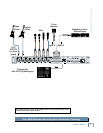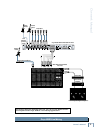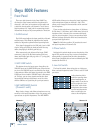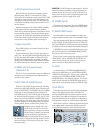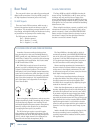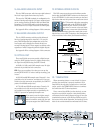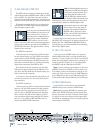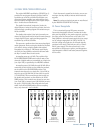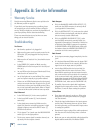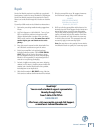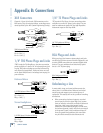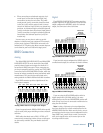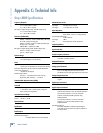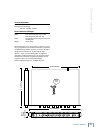
14
ONYX 800R
ONYX 800R
SIDE MID
OPTICAL OUT
88.2/
96kHz
176.4/
192kHz
44.1/48kHz
1-8 1-81-4 5-8
1-2
3-4
ANALOG MICROPHONE PREAMP WITH 192kHz DIGITAL OUTPUT
BALANCED LINE LEVEL
INPUT
BALANCED LINE LEVEL
OUTPUT
AES/EBU OR S/PDIF OUT
AES/EBU = 110Ω / PRO
SPDIF = 75Ω / CONSUMER
~
100-240 VAC
50-60Hz 105W
87654321
110Ω
75Ω
NORMAL
MID/SIDE
PRO
CONS
DUAL WIRE
SINGLE WIRE
O
N
Y
X
M
I
C
P
R
E
O
N
Y
X
M
I
C
P
R
E
O
N
Y
X
M
I
C
P
R
E
O
N
Y
X
M
I
C
P
R
E
O
N
Y
X
M
I
C
P
R
E
O
N
Y
X
M
I
C
P
R
E
O
N
Y
X
M
I
C
P
R
E
O
N
Y
X
M
I
C
P
R
E
MID/SIDE
DECODE
TERMINATION
OFF
ON (75Ω)
EXTERNAL
WORD
CLOCK IN
Note: Transferring digital audio over a
cable generates EMI (electromagnetic
interference) around the cable. Use a
high-quality shielded cable to mini-
mize the EMI noise radiated around
the cable. For example, Belden’s 7880A cable shields each
individual pair of wires as well as the entire cable, and is
recommended by Belden for AES/EBU digital audio.
In general, the shorter the cable length,
the less effect it has on the quality of
the signal. The maximum length for an
AES/EBU cable is 100 meters (about
325 feet), and a S/PDIF cable is limited
to 10 meters (about 32 feet).
The three buttons located just above the AES/EBU
OR S/PDIF OUT connector can be used to customize the
digital signal. The 110Ω/75Ω and PRO/CONS buttons
in particular give you added fl exibility when interfacing
with “fi nicky” digital inputs.
22. 110Ω/75Ω Switch
If you are using the AES/EBU format, the output is a
balanced differential signal at a voltage specifi ed at be-
tween 2 to 7 V peak-to-peak into 110 ohms. In the S/PDIF
format, the output signal is unbalanced at a voltage of 0.5
V peak-to-peak into 75 ohms. So use the 110Ω position
for AES/EBU, and the 75Ω position for S/PDIF.
Note: If you are using any kind of adapter to convert an
AES/EBU connector to a S/PDIF connector, check to see
if the adapter converts the impedance as well as the con-
nector type. If this is the case, leave the 110Ω/75Ω switch
in the 110Ω position. Only use the 75Ω position with true
75-ohm coaxial cable connected directly to a S/PDIF input.
23. PRO/CONS Switch
Use this switch to select between the professional
AES/EBU format or the consumer S/PDIF format.
Note: Strictly speaking, AES/EBU can transmit up to
24-bits, while S/PDIF is limited to 20-bits because four
bits are reserved for “user bits.” However, if 24-bit depth
is selected, the four user bits are used for digital audio
and 24-bits are transmitted (this is an accepted optional
implementation of S/PDIF).
21. AES/EBU OR S/PDIF OUT
This DB25 connector produces a digital output for all
eight channels in either AES/EBU format (PRO) or S/PDIF
format (CONS). The audio data is the same for either
format, but the electrical characteristics (voltage level, im-
pedance) and non-audio data bits (subcode) are different.
This can be connected directly to a recording device
with AES/EBU or S/PDIF inputs using an appropriate
digital recorder interface cable.
By the way, the most wonderful thing
about standards is that there are so
many to choose from. A variety of
alternate pin-out confi gurations are
being used by various manufactur-
ers for the AES/EBU DB25 interface. You will need to
make a conversion cable when connecting between two
devices that use different pin-outs for the AES/EBU or
S/PDIF DB25 connectors. See Appendix B for a wiring
diagram of this connector.
For AES/EBU connections:
1. Most devices use a balanced 3-pin XLR connector
for two-channel inputs, or a 25-pin DB25 connector for
eight channels. Special AES/EBU cables are available
from various manufacturers with DB25 connectors on
both ends, or breakout cables are available for making
digital audio connections from DB25 to XLR.
These off-the-shelf cable harnesses have four male
XLRs for the outputs, and four female XLRs for the in-
puts. Since the Onyx 800R only has digital outputs, you
won’t use the female connectors.
2. If you want a more streamlined cable harness, you
can make your own (or have one made) with only the
four connectors.
For S/PDIF connections:
1. Most devices use an RCA connector for two-channel
inputs, or a 25-pin DB25 connector for eight channels.
Your best option for connecting to devices with RCA
jacks is to use an AES/EBU breakout cable described
above, and fi t it with XLR-to-RCA adapters (or build
your own custom cable harness with four RCA connec-
tors on it). Use a DB25-to-DB25 AES/EBU cable for
devices with DB25 S/PDIF connections.




